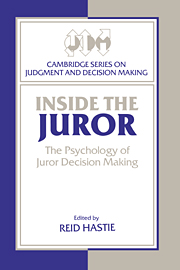Book contents
- Frontmatter
- Contents
- Series preface
- List of contributors
- Editor's preface
- Acknowledgments
- Part I Models of juror decision making
- Part II Commentaries
- 9 Notes on the sampling of stimulus cases and the measurement of responses in research on juror decision making
- 10 Sausages and the law: Juror decisions in the much larger justice system
- 11 A rational game theory framework for the analysis of legal and criminal decision making
- 12 Why do jury research?
- 13 Two conceptions of the juror
- 14 A mathematician comments on models of juror decision making
- Index of names
- Index of subjects
9 - Notes on the sampling of stimulus cases and the measurement of responses in research on juror decision making
Published online by Cambridge University Press: 04 August 2010
- Frontmatter
- Contents
- Series preface
- List of contributors
- Editor's preface
- Acknowledgments
- Part I Models of juror decision making
- Part II Commentaries
- 9 Notes on the sampling of stimulus cases and the measurement of responses in research on juror decision making
- 10 Sausages and the law: Juror decisions in the much larger justice system
- 11 A rational game theory framework for the analysis of legal and criminal decision making
- 12 Why do jury research?
- 13 Two conceptions of the juror
- 14 A mathematician comments on models of juror decision making
- Index of names
- Index of subjects
Summary
Phoebe Ellsworth fails to find much effect of attitude on verdict. Having been personally involved in over 150 similar judgments of “guilt or innocence” by serving on two separate professional ethics committees, I was astounded. Why might Professor Ellsworth's correlations between attitudes and judgment be so low?
My first reaction was that she may have looked at the wrong variables; specifically, I would have suggested looking at age (the everyday observation that old people tend to be more conservative than young people is borne out by surveys) and occupation. She did.
But then I thought of the analogy of the single legal case to the single item on an intelligence test. Certainly, we would not expect to predict success in an intellectual endeavor very well from the response to a single intelligence test item. If we were to find – analogous to what Ellsworth found – a very low correlation between one item and the task performance, there are two possible explanations. The first is that even if intelligence were assessed with multiple items, it would not predict performance well; the second is that the number of items sampled was too small.
The only way to distinguish between these two possibilities is to use many items. Analogously, the only way to distinguish failure due to using a single case from the possibility that attitude does not predict verdict in general is to investigate many different verdicts on many different trials.
- Type
- Chapter
- Information
- Inside the JurorThe Psychology of Juror Decision Making, pp. 225 - 228Publisher: Cambridge University PressPrint publication year: 1993
- 1
- Cited by



